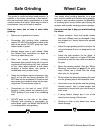
This section covers the most common problems encountered in grinding and what to do about them. Do
not make any adjustments until grinder is unplugged and moving parts have come to a complete stop.
TROUBLESHOOTING
SYMPTOM
Motor will not start.
Motor will not start; fuses or
circuit breakers blow.
Motor overheats.
Motor stalls (resulting in
blown fuses or tripped cir-
cuit).
Machine slows when oper-
ating.
Wavy condition on surface
of workpiece.
Lines on surface of work-
piece.
Burning spots or cracks in
the workpiece.
Wheel dulls quickly, grit falls
off.
Wheel clogs and workpiece
shows burn marks.
POSSIBLE CAUSE
1. Low voltage.
2. Open circuit in motor or loose
connections.
1. Short circuit in line cord or plug.
2. Short circuit in motor or loose
connections.
3. Incorrect fuses or circuit break-
ers in power line.
1. Motor overloaded.
1. Short circuit in motor or loose
connections.
2. Low voltage.
3. Incorrect fuses or circuit breakers
in power line.
4. Motor overloaded.
1. Depth of cut too great.
1. Machine vibrating.
2. Workpiece not being held firmly.
3. Wheel face uneven.
4. Wheel is too hard.
1. Impurity on wheel surface.
2. Workpiece not being held tightly.
1. Improper type of grinding wheel.
2. Improper feed rate.
3. Coolant required.
1. Depth of cut too great.
2. Wheel is too soft.
3. Wheel diameter too small.
4. Bad wheel dress.
5. Defective wheel bonding.
1. Wheel is too hard.
2. Feed rate too slow.
3. Bad wheel dress.
4. Coolant required.
CORRECTIVE ACTION
1. Check power line for proper voltage.
2. Inspect all lead connections on motor for loose or open connec-
tions.
1. Inspect cord or plug for damaged insulation and shorted wires.
2. Inspect all connections on motor for loose or shorted terminals or
worn insulation.
3. Install correct fuses or circuit breakers.
1. Reduce load on motor.
1. Inspect connections on motor for loose or shorted terminals or
worn insulation.
2 Correct the low voltage conditions.
3. Install correct fuses or circuit breakers.
4. Reduce load on motor.
1. Slow down the rate of movement of the workpiece into wheel.
1. Make sure machine is securely mounted on a solid surface.
2. Use a holding device to firmly retain the workpiece.
3. Dress the grinding wheel.
4. Use softer wheel, or reduce the feed rate.
1. Dress the grinding wheel.
2. Use a holding device to firmly retain the workpiece.
1. Try a wheel which is softer style or a coarser grit.
2. Slow down the rate of movement of the workpiece into wheel.
3. Add optional coolant system or introduce coolant by hand.
1. Slow down the rate of movement of the workpiece into wheel.
2. Wheel too soft for the material being ground, select harder bond.
3. Replace the wheel.
4. Dress the wheel.
5. Consult manufacturer of grinding wheel.
1. Wheel too hard for the material being ground, select softer bond.
2. Increase the rate of movement of the workpiece into wheel.
3. Dress the wheel.
4. Add optional coolant system or introduce coolant by hand.
H4378/H4379 Slimline Bench Grinder -17-
Disconnect power to the
machine when perform-
ing any maintenance,
assembly or adjust-
ments. Failure to do this
may result in serious
personal injury.
!


















